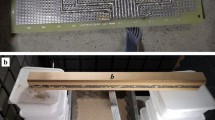Summary
-
1.
The dependence of some mechanical parameters on defined stimulation by air medium vibration is described for vibration sensitive hairs on the thorax ofBarathra brassicae caterpillars.
-
2.
The adequate stimulus for the hairs is a forced oscillation by medium vibration. There are 8 hairs on the thorax responsive to medium vibration: 4 on the 1st and 2 on the 2nd and 3rd segment each.
-
3.
The hairs' geometric parameters are: length: 450–650μm (average: 500μm), basal diameter: 4–8 μm (average: 5 μm), average volume: 3300μm3, average mass 3.6 · 10−9 g.
-
4.
The hairs on the first thoracic segment are bent and show an elliptic directional characteristic of mobility which is caused by the bending (Fig. 4). The straight erect hairs on the second and third segment show a circular profile of mobility (Fig. 2). All hairs can be bent to maximally 15° on each side from the resting position without touching the circular rim of their cuticular insertion.
-
5.
The displacement resonance frequency of the hairs is in the range of 100–150 Hz. The loss factord 0 and its reciprocal, theQ-factor, is determined to about 1.
-
6.
Free oscillations of the hair are heavily damped. The frequency of the free damped oscillation is in the range of 130–250 Hz, the log decrement is about 4.0.
-
7.
The necessary force for a constant hair displacement is dependent upon frequency. If one plots particle-displacement-amplitude against frequency a +12 dB/octave slope is found at higher frequencies.
-
8.
At a driving frequency of 100 Hz, the hair acts as a linear system up to a deviation angle of 10°. For higher angles the hair gets progressively stiffer.
-
9.
A mechanical model consistent of mass, resistance and compliance is developed for mechanoreceptive hairs of insects. This model is discussed in respect to the experimental results, to the physics of force driving the hair and the function of the filiform hairs as medium vibration receptors. The results show that the filiform hairs are almost optimally adapted receivers for air medium vibration in the frequency range 100–400 Hz for hair displacements not exceeding 0.2° from resting position.
Similar content being viewed by others
References
Altmann, P.L., Dittmer, D.S.: Biology data book, Vol. III. Bethesda: Federation of American Societies for Experimental Biology 1975
Beranek, L.: Acoustics. New York: McGraw-Hill 1954
Bischof, H.-J.: Verteilung und Bewegungsweise der keulenförmigen Sensillen vonGryllus bimaculatus. Biol. Zbl.93, 449–457 (1974)
Burkhardt, D.: Die Eigenschaften und Funktionstypen der Sinnesorgane. Ergebn. Biol.22, 226–267 (1960)
Chapman, K.M., Duckrow, R.B.: Compliance and sensitivity of a mechanoreceptor of the insect exosceleton. J. comp. Physiol.100, 251–268 (1975)
Görner, P., Andrews, P.: Trichobothrien, ein Ferntastsinnesorgan bei Webspinnen (Araneen). Z. vergl. Physiol.64, 301–317 (1969)
Hoffmann, Ch.: Bau und Funktion der Trichobothrien vonEuscorpius carpathicus L. Z. vergl. Physiol.54, 290–352 (1967)
Jensen, M., Weis-Fogh, T.: Biology and physics of locust flight. V. Strength and elasticity of locust cuticle. Phil. Trans. B245, 137–163 (1962)
Landau, L.D., Lifschitz, E.M.: Lehrbuch der theoretischen Physik, Bd. VI Hydrodynamik. Berlin: Akademie-Verlag 1966
Markl, H., Tautz, J.: The sensitivity of hair receptors in caterpillars ofBarathra brassicae L. (Lepidoptera, Noctuidae) to particle movement in a sound field. J. comp. Physiol.99, 79–87 (1975)
Meyer, E., Guicking, D.: Schwingungslehre. Braunschweig: Vieweg 1974
Michelsen, A.: The physiology of the locust ear. II. Frequency discrimination based upon resonances in the tympanum. Z. vergl. Physiol.71, 63–101 (1971)
Nicklaus, R.: Die Erregung einzelner Fadenhaare vonPeriplaneta americana in Abhängigkeit von der Größe und Richtung der Auslenkung. Z. vergl. Physiol.50, 331–362 (1965)
Petrovskaya, E.D., Rozhkova, G.I., Tokareva, V.S.: Single cercal receptor characteristics in the cricket (Gryllus domesticus). Biofizika15, 112–119 (1970) [Russ., Engl. Summary]
Skudrzyk, E.: Die Grundlagen der Akustik. Wien: Springer 1954
Smola, U.: Untersuchung zur Topographie, Mechanik und Strömungsmechanik der Sinneshaare auf dem Kopf der WanderheuschreckeLocusta migratoria. Z. vergl. Physiol.67, 382–402 (1970)
Snowdon, J.C.: Vibration and shock in damped mechanical systems. New York: John Wiley & Sons 1968
Yes'kov, Y.K.: Phonoreceptors of honey bees. Biofizika20, 646–651 (1975)
Author information
Authors and Affiliations
Additional information
With support of the Deutsche Forschungsgemeinschaft, grants to Prof. Dr. H. Markl (Ma 374/2,4,6 and 741,29/3)
I thank Prof. Dr. H. Markl who supported this work in every sense. I wish to thank Prof. Dr. A. Michelsen for valuable comments on an earlier version of this paper and Dr. E. Frehland and Dr. G. Kemper for critical discussion.
Rights and permissions
About this article
Cite this article
Tautz, J. Reception of medium vibration by thoracal hairs of caterpillars ofBarathra brassicae L. (Lepidoptera, Noctuidae). J. Comp. Physiol. 118, 13–31 (1977). https://doi.org/10.1007/BF00612334
Received:
Issue Date:
DOI: https://doi.org/10.1007/BF00612334




